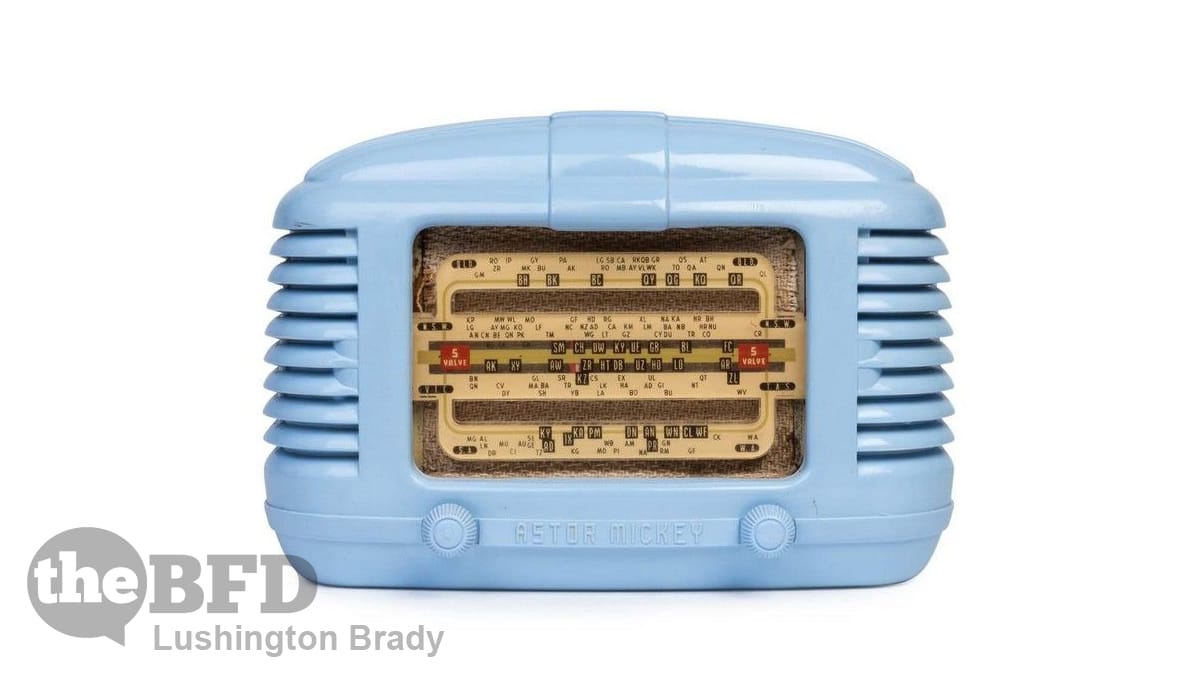Some time ago, I was browsing through an antique shop when, to my delight, I chanced upon an old bakelite radio. This is almost exactly the same as the one my family used to have! I told the proprietor.
“What colour was it?” she asked. When I told her it was blue, her eyes went wide. A common-or-garden brown one, as the shop had, sold for a few hundred dollars. A blue one such as I described would fetch nearly $2000. (When it comes to the ultra-rare red ones, name your price.)
Sadly, I had to confess, Gran’s old bakelite radio had long gone to God.
My family inherited my grandmother’s old radio sometime before the middle 60s. In my earliest memories, I see it sitting on the bench in the kitchen, where we would all listen to it at breakfast time. It’s a very cosy, family kind of memory. Probably for my parents, it evoked memories of their families, gathered around the wireless, in the pre-television world they grew up in.
It was powder-blue, that radio, and made with the classic, streamlined contours of 1920s Art Deco appliances. It had white knobs and an enormous tuning dial, printed with, not frequencies, but the actual names of radio stations. Dozens of stations, more than I could have imagined existed. They were grouped by Australia’s states, and I think that perhaps, in some small way, seeing those radio stations and states on that tuning dial sparked my first dim realisation that Australia was so much vaster than the small world I was then aware of.

Its make and model name “Astor Mickey”, I vaguely assumed was somehow related to the Disney cartoons. This somewhat impressed me, even though I generally disliked Disney cartoons: They were just a little too saccharine for my liking, even then, with none of the violent snarkiness that made the Warner Bros. cartoons so much more appealing. Still, a cartoon character was a cartoon character, and that was enough to make the name Mickey sound cool enough to my childish ears.
What I remember most is looking through the back of the radio, and watching its valves glowing gently in the darkness of its interior. Seeing those glass cylinders, with their intricately wired innards glowing orange, it seemed to me that I was somehow stealing a glimpse into the mysteries of science.
Eventually, for whatever reason, the Bakelite radio was replaced — no doubt by some modern, transistorised contraption. Possibly my Dad’s old radio which I still have, with its ability to switch between AM, FM and two bands of short-wave. My brothers and I used to spend hours wandering the short-wave bands, picking up the static-saturated broadcasts of stations from all over the world, as well as the radio-howl and doppler-distorted transmissions from aircraft.
So, Gran’s old bakelite radio was exiled to the bedroom I shared with my two older brothers. It was now the early 70s, and one of my brothers used a heated nail to melt a hole in the tuning dial, marking out the only radio station that mattered to any kid in Melbourne in the 70s – 3XY.
3XY was the sound of Australian rock’n’roll in the 70s, scruffy, loud and raucous. 3XY was AC/DC, the Masters’ Apprentices and Skyhooks. In our little bedroom, crammed with a double bunk a single bed, and papered with pictures of rock bands that my brothers cut out of their magazines, it was Gran’s Bakelite radio that brought those sounds to me. Like the protagonist of Lou Reed’s Rock’n’roll, I listened to that “fine, fine music”. Well, okay, maybe my life wasn’t exactly saved by rock’n’roll, but that radio certainly meant a lot to me.
I suspect one of the valves eventually burnt out. I only wish I’d had the appreciation to keep it. Not for the fact that it would be worth a small fortune because I’m not sure I would ever sell it. Is it stupid to invest so much emotional attachment in a piece of outmoded, early 20th-century technology?
These collectors certainly don’t think so.






